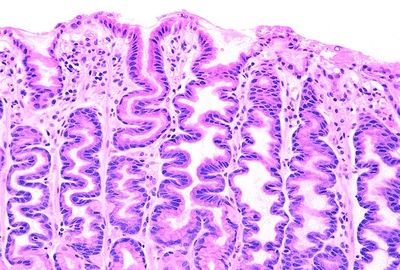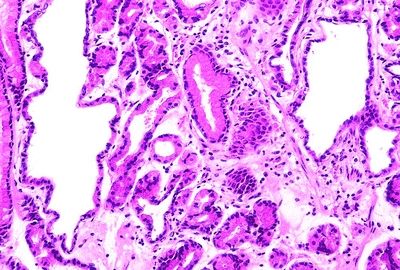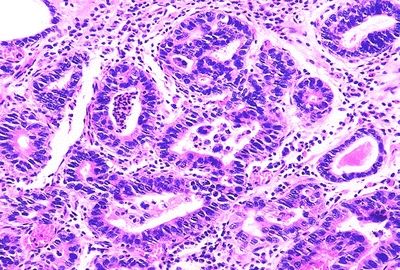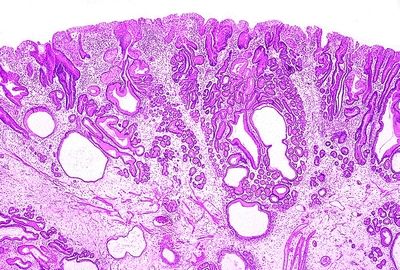QUESTION 32.3
A. Autoimmune gastritis
B. Granulomatous gastritis
C. H. pylori gastritis
D. Lymphocytic gastritis
E. Reactive gastropathy (chemical gastritis)
4. Which of the following types of chronic gastritis is associated with the development of gastric peptic ulcer and gastric adenocarcinoma?
A. Autoimmune gastritis
B. Diffuse antral gastritis
C. Lymphocytic gastritis
D. Multifocal atrophic gastritis
E. Reactive gastropathy (chemical gastritis)
5. A 54-year-old patient presents with a 6-month history of progressive fatigue. Severe megaloblastic anemia is documented on blood tests. Endoscopic and biopsy studies reveal chronic atrophic gastritis involving the fundus and sparing the antral region. Which of the following pathogenetic mechanisms is prevalent in this form of gastritis?
A. Alcohol abuse
B. Autoimmune
C. Duodenal reflux
D. H. pylori infection
E. Tobacco abuse
6. Which of the following conditions is most commonly associated with lymphocytic gastritis?
A. Celiac disease
B. Crohn disease
C. Food allergy
D. Treatment with proton pump inhibitors
E. Whipple disease
7. A gastric biopsy shows the alterations demonstrated in this photomicrograph. Which of the following is the most likely diagnosis?

QUESTION 32.7
A. Eosinophilic gastritis
B. Granulomatous gastritis
C. Helicobacter gastritis
D. Lymphocytic gastritis
E. Reactive gastropathy
8. Gastric polyps are discovered in approximately 6% of individuals undergoing endoscopic examination. This photomicrograph shows the characteristic morphology of the most frequent of them. Which one is it?

QUESTION 32.8
A. Adenomatous polyp
B. Fundic gland polyp
C. Hamartomatous polyp
D. Hyperplastic polyp
E. Inflammatory fibroid polyp
A. Adenomatous polyp
B. Fundic gland polyp
C. Hamartomatous polyp
D. Hyperplastic polyp
E. Inflammatory fibroid polyp
10. A 60-year-old man presents with colicky abdominal pain. An esophagogastroduodenoscopy reveals a large sessile polyp in the antral region. Its histologic appearance is shown in this picture. Which type of polyp is it?

QUESTION 32.10
A. Adenomatous polyp
B. Fundic gland polyp
C. Hamartomatous polyp
D. Hyperplastic polyp
E. Inflammatory fibroid polyp
11. Which of the following types of gastric adenomas has the highest risk of malignant transformation?
A. Adenomas with gastric differentiation
B. Adenomas with intestinal differentiation
C. Flat adenomas
D. Pyloric gland adenomas
12. The gross appearance of gastric mucosa in Zollinger-Ellison syndrome is similar to:
A. Autoimmune gastritis
B. Gardner syndrome
C. Juvenile polyposis
D. Hypertrophic hypersecretory gastropathy
E. Inflammatory fibroid polyps
13. There is a definite, although weak, association between the form of gastric adenocarcinoma shown in this picture and which of the following forms of metaplasia?

QUESTION 32.13
A. Intestinal metaplasia, large bowel type, complete
B. Intestinal metaplasia, large bowel type, incomplete
C. Intestinal metaplasia, small bowel type, complete
D. Intestinal metaplasia, small bowel type, incomplete
E. Pyloric metaplasia
14. Partial gastrectomy that has been present for at least 20 years carries a significantly increased risk for developing gastric carcinoma:
A. True
B. False
15. Which of the following statements on classification of gastric carcinoma is correct?
A. Matched stage for stage, all histologic types have similar prognosis.
B. Intestinal type is synonymous of well-differentiated, diffuse type of poorly differentiated.
C. Location of the tumor has no relevance in current staging systems.
D. WHO classification recognizes two histologic types, intestinal and diffuse.
E. All of the above
16. The most characteristic molecular change found in the type of gastric carcinoma shown in this picture is:

QUESTION 32.16
A. Demethylation of melanoma antigen family (MAGE) and synuclein-γ (SNCG)
B. Methylation and silencing of P16, MLH1, MGMT, and Runx 3
C. Loss of function of the E-cadherin gene (CDH1)
D. Microsatellite instability
E. Somatic mutations of mismatch repair genes
17. Which of the following is the most important prognostic factor in gastric adenocarcinoma?
A. CA19-9 levels
B. CEA level
C. HER2 amplification
D. Pathologic stage
E. Patient age
F. Tumor histologic type
G. Tumor location
H. Tumor size
18. Which of the following is the most accurate definition of superficial spreading (“early”) gastric carcinoma?
A. Adenocarcinoma that has not penetrated the basement membrane
B. Carcinoma associated with a 50% 5-year survival rate
C. Carcinoma limited to mucosa/submucosa without node metastasis
Stay updated, free articles. Join our Telegram channel

Full access? Get Clinical Tree



